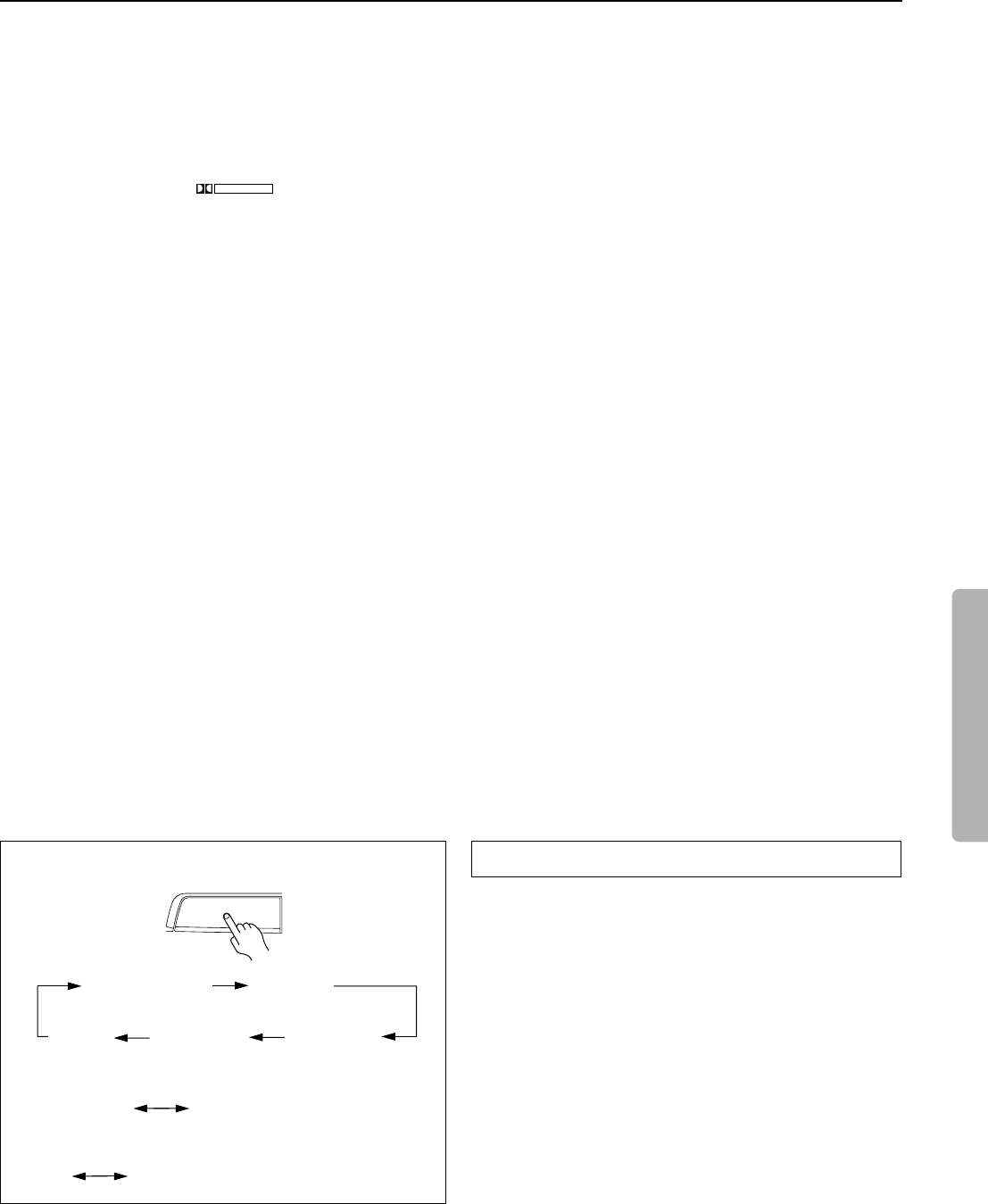
21
To enjoy Surround mode or Stereo mode
DOLBY PRO LOGIC
This surround format consists of four channels (left and right front,
center, and monaural surround channels) and emphasizes the cen-
ter channel. This format is very effective for panning music, con-
versation, and three-dimensional sound movement output from
three front channels. It also simulates the atmosphere and surround
effects of the sound reflected from the side and rear walls of the
theater. Select this option when you play a VHS, VHS Hi-Fi, laser
disc, or DVD video that has a mark.
Onkyo’s Surround modes
The TX-DS484 offers the following special Onkyo Surround
modes for the sources other than Dolby Digital and DTS sounds.
ORCHESTRA: This mode is suitable for classics and opera
music. The center channel is cut and the surround channels are
emphasized to widen the stereo image. It will simulate a natural
reverberation that can be created in a large hall.
UNPLUGGED: This mode is suitable for acoustic instrumental
sounds, vocals, and jazz music. By emphasizing the front stereo
image, it will simulate the acoustics in front of the stage.
5CH STEREO: This mode is useful for background music.
The front and surround channels will create a stereo image.
STEREO
Select this mode when you do not wish to use the surround mode.
All input sound is output from the front speakers.
• A system with L/R front and center speakers
The following modes are available:
DOLBY 3STEREO
The surround channel sound is output from the left and right
front speakers.
STEREO
This is a normal stereo mode. Surround mode is cancelled.
• A system with L/R front speakers
The following mode is available:
STEREO
This is a normal stereo mode.
Notes on DTS
1. If you play a CD or LD that supports DTS when the “ANA-
LOG” setting is selected on the TX-DS484, the DTS encoded
signal will not be decoded and noise will be output. This noise
could damage the amplifier and speakers. Therefore, be sure to
select “DIGITAL” and use the digital input jacks (OPTICAL/
COAXIAL) to connect the DTS source. (Refer to “Switching
between digital and analog inputs” on page 19.)
2. If you play a CD or LD that supports DTS when the “DIGITAL”
setting is selected, you may hear a noise for a short while until the
DTS decoder recognizes the DTS encoded signal and starts oper-
ating. This is not a malfunction.
3. If you press the PAUSE or SKIP button on the player while play-
ing a DTS source, a short noise may be heard. This is not a mal-
function.
4. The DTS indicator on the TX-DS484 lights up while it plays the
DTS source. When playback concludes and the DTS signal trans-
mission stops, the TX-DS484 remains in DTS mode and the DTS
indicator remains lit. This prevents noise when you operate the
PAUSE or SKIP button on the player. Therefore, if the source
switches from the DTS signal to the PCM signal immediately, the
PCM signal may not be played. In this case, stop the playback of
the source on the player for about three seconds, then resume
playback.
5. Some CD players and LD players may be unable to play DTS
sources correctly even if you connect the player to the TX-DS484
digitally. This is because the digital signal has been processed
(such as the output level, sampling frequency, frequency
response, etc.), and the TX-DS484 cannot recognize the signal as
DTS data. Therefore, you may hear noise when you play a DTS
source while processing the signal.
6. The Rec Out jacks of the TX-DS484 output analog audio. Do not
record CDs or LDs that support DTS using these jacks. Other-
wise, you will record a DTS encoded signal as noise.
1. Press an Input Selector button to select the desired sound
source.
2. Press the SURROUND MODE button repeatedly until the
desired Surround mode name appears.
The display changes in the order shown on left each time you
press the button.
• If you are using the remote controller, press the SUR MODE
button to select the desired Surround mode.
• If DOLBY PRO LOGIC is selected during playback of a
DOLBY DIGITAL or DTS source, the Surround mode automat-
ically changes to DOLBY DIGITAL or DTS and the DOLBY
DIGITAL indicator or DTS indicator lights up on the display.
• If you have set the surround speaker parameter for the speaker
setup (see page 14) to “NONE,” STEREO or 3 STEREO will be
selected for Surround mode
3. Play the selected sound source.
DOLBY SURROUND
PRO LOGIC
Selecting a Surround mode
Dolby Pro Logic
Unplugged
Orchestra
Stereo 5ch Stereo
SURROUND MODE
Playing the DOLBY DIGITAL source
Dolby Digital Dolby Digital (stereo)
Playing the DTS source
DTS DTS (stereo)
You can adjust the level of each speaker if necessary.
1. Use the CH SEL button on the remote controller to select the target speaker.
2. Use the LEVEL π or † button to adjust the level.
When you place the receiver in Standby mode, this level will be reset to the value set for the test tone. Also, if you press the TEST TONE
button after adjusting the speaker level, it will use the level value set for the test tone.


















